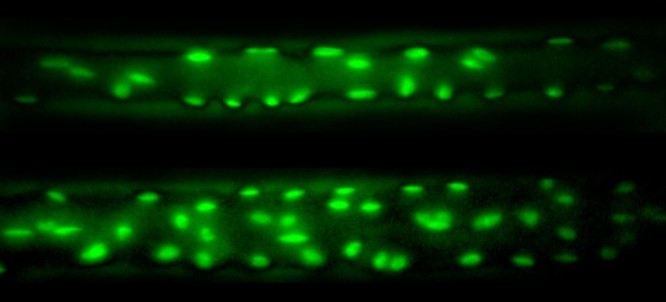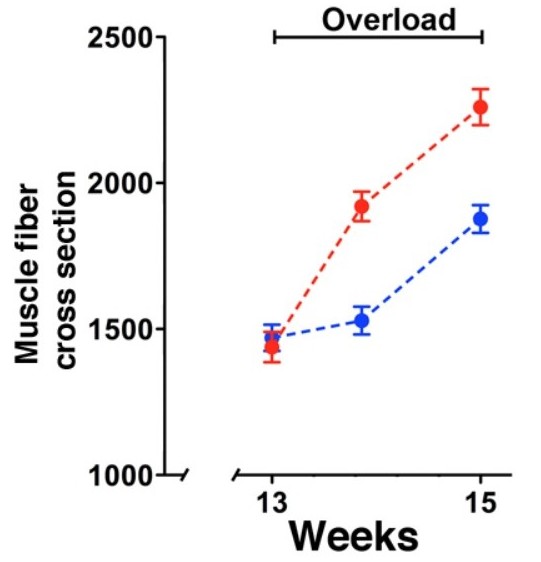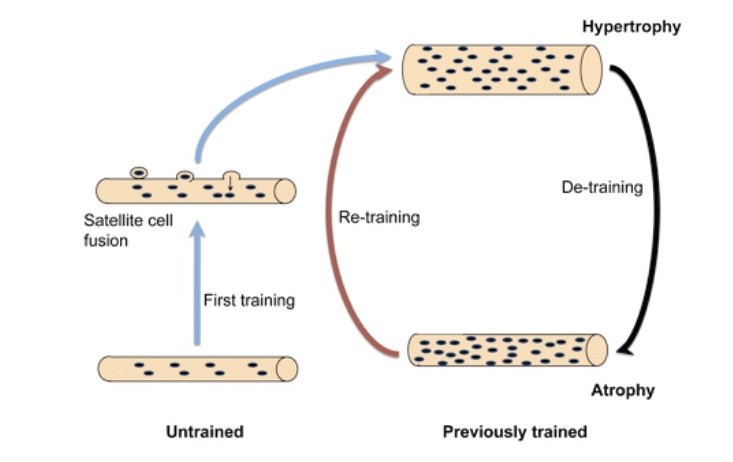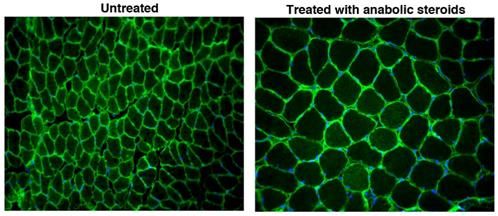Steroids probably result in a lasting benefit for its users
Recently another new scientific study resulted in a lot of new articles on the world wide web. I wrote about muscle memory before (Muscle memory fact or fiction //www.napsgear.net/jm_blog_news.php?id=34 ). The way we look is due to a many different reasons. First of all being our genetic body type.
If you read the diverse articles (including mine //juicedmuscle.com/jmblog/content/whats-your-body-type ) about it you know that some body types can more easily gain muscle than others. Still everyone can become a bodybuilder.
Microscopy images showing cross sections of muscle fibers with (right) and whiteout (lest) anabolic steroids.
You are born as a certain body type, mostly not as one of the main three but mostly a combination of all the body types. It is very important for the fact how you will look later in life, how young you started to train. Or how much fat mass you gained when you were young. And how much physical work you did when you were young. The human body adapts to the environmental situation. It is obvious that someone who grew up at a farm and helped working hard and heavy develops an other body then a simular type of person that grew up in the big city never to lift a finger.
There is a strong correlation between muscle strength and lean body mass as well as skeletal size. The genetic contribution to muscle strength, as assessed by heritability studies, may be up to 65 percent, but this still leaves scope for the influence of environmental factors. The major environmental correlate of muscle strength during adult life is physical activity. In addition, adult muscle mass and strength might be modifiable by environmental influences acting at critical periods during intrauterine and early postnatal life. Recent studies have shown that birth weight is positively correlated with adult muscle mass, muscle metabolism, and muscle strength.
Sadly enough next to muscle memory we also know a condition known as fat memory. This results in a certain body composition. Just as with muscle part of our fat mass is genetic and part due to your nutrition. I will adress this issue in another blog article .
Until recently it was believed that during muscle wasting (atrophy) muscle cells lost nuclei by a nuclear self-destruct mechanism called apoptosis (cell death), but recent observations using time laps in vivo imaging in mice do not support this model. Direct observation indicated that no nuclei are lost under such conditions, and the apoptosis observed in the muscle tissue were demonstrated to occur only in other cell nuclei in the tissue, e.g. connective tissue and muscle stem cells (called satellite cells). Since in vivo imaging has confirmed that cell nuclei are added during strength training and not lost upon subsequent detraining, the nuclei might provide a mechanism for muscle memory. Thus, upon retraining the extra nuclei are already there and can rapidly start synthesizing new protein to build muscle mass and strength. The extra muscle nuclei obtained by a strength training episode, seems to be very long lasting, perhaps permanent, even in muscles that are inactive for a long time. The ability to recruit new nuclei is impaired in the elderly, so it might be beneficial to strength train before senescence. Doping with anabolic steroids also seem to act partly by recruiting new nuclei, so it is possible that AAS (anabolic androgenic steroids) give athletes a long lasting (perhaps life long) benefit compared to athletes that not use AAS.

Big muscle cells (below) contain more nuclei than do small muscle cells (above)
In the new study, researchers led by Kristian Gundersen, a physiologist at the University of Oslo, tested the effect of steroids on female mice. The team had previously shown that exercise builds new nuclei in muscle cells. Nuclei are the cellular compartments where DNA is stored, and muscle cells typically have multiple nuclei. Increasing the number of nuclei gives muscles the capacity to build more proteins
Steroids may continue to boost muscle-building capacity long after a person stops taking the drugs, a new study of mice suggests. The finding could mean that athletes who cheat by taking anabolic steroids should be suspended from competition for a decade or longer.
The research also suggests that building muscles in youth may have benefits that last into old age. Since the ability to generate new myonuclei is impaired in the elderly our data also invites speculation that it might be beneficial to perform strength training when young in order to benefit in senescence.
Doses of the steroid testosterone caused the mice to add nuclei to their muscles, the researchers report October 28 in the Journal of Physiology. After two weeks of steroid treatment (testosterone propionate), the muscle cells had up to 66 percent more nuclei per muscle fiber. Mice that didn’t get steroids, but had surgery that cut one muscle to make another work harder, had 51 percent more nuclei in the overworked muscle. Mice that got both steroids and surgery built 92 percent more nuclei in their uncut muscle.
 Graphic: Quantifications of cross sectional area. Muscles treated with steroids 13 weeks earlier (red) grew significantly faster that sham-treated animals (blue) when subjected to overload of the muscle.
Graphic: Quantifications of cross sectional area. Muscles treated with steroids 13 weeks earlier (red) grew significantly faster that sham-treated animals (blue) when subjected to overload of the muscle.
The mice’s muscle cells also bulked up, but eventually shrank back to pre-steroid size after the drugs were stopped. The new nuclei didn’t go away, though, Gundersen’s team found. Steroid-treated muscles kept their ill-gotten nuclei for at least three months, which corresponds to about a decade in humans’ life span. The effect may last even longer, but the researchers did not extend the experiment to find out.
When muscles were worked three months after the steroid treatment stopped, the muscle mass of animals that previously took testosterone bounced back right away, bulking up 31 percent in the first six days. Mice that never took steroids only added about 6 percent to their muscle mass during that time.
“In my career it has been rare to see such clear results,” Gundersen says. “It is more dramatic than I thought it would be.”
Other researchers are also impressed with the results.
“There’s no question it’s very interesting data and it’s very strong,” says Bengt Saltin, a physiologist at the University of Copenhagen. “This should be a hotter topic in muscle research and physiology,” he says. Elderly people often have trouble with muscle wasting, and the new study suggests that working out in young adulthood could help old muscles regain vigor with exercise later.
Lawrence Schwartz, a cell biologist at the University of Massachusetts Amherst, agrees. “The implication is once you have these nuclei, you never lose them.”
The findings might have consequences for the exclusion time of doping offenders as brief exposure to anabolic steroids might have long lasting performance-enhancing effects.
Prof Gundersen says: "The results in our mice may correspond to the effects of steroids lasting for decades in humans given the same cellular 'muscle memory' mechanism. The new results might spur a debate on the current World Anti-Doping Agency (WADA) code in which the maximum exclusion time is currently two years."
Both researchers also say that before anti-doping agencies can decide how long cheating athletes should be barred from competition, similar research to see how long steroids exert their influence would need to be done on humans.
“I suspect the basics of muscle physiology are going to be very similar," Schwartz says of mice and humans. But given the side effects of steroids and the difficulty of studying large samples of muscle in living people without causing harm, “I don’t see any easy, or even an ethical way of doing this in humans.”
A possibility could be to take muscle biopsies from athletes who have admitted using steroids.
 The picture on the right shows what happens when you stop training your muscles. You'll end up with a sagging butt (and arms and breasts). If the girl on the left has been training before and she would start squatting, her butt cheeks would soon look like the one on the right.
The picture on the right shows what happens when you stop training your muscles. You'll end up with a sagging butt (and arms and breasts). If the girl on the left has been training before and she would start squatting, her butt cheeks would soon look like the one on the right.
It would make us, men, happy if all girls would train gluteus maximus muscle. so nice...
Muscle Memory and nuclei number
In order to better understand the causes of muscle memory, a recent experiment put rodent’s muscles under load and found that the muscle nuclei started to increase by day six. The muscles began growing in size by day nine, and by day 21 the hard working muscle had increased its nuclei by 54%! Basically, it was shown that the nuclei come first and muscle mass later.
In a related experiment, after training the rodent’s muscles for two weeks, they cut the nerves leading to the muscle causing it to shrink from disuse. As the muscle got smaller, it deflated to about 40% of its bulked up size—BUT the number of nuclei in the muscle DID NOT CHANGE. Three months later they were still there, and while researchers currently do not know how long the effect will last, it is apparent that the added nuclei stay a long time.
The picture below explains the process:

- Login to post comments



